Sonara
JF-Expert Member
- Oct 2, 2008
- 726
- 68
[h=1]Ancient cannibals used chillies and spices to 'marinate' their victims - and the exotic ingredients stained human BONES[/h]
Published: 12:44, 21 May 2015 | Updated: 13:17, 21 May 2015
A gruesome recipe has been uncovered that explains how ancient cannibals prepared their human meals.
Researchers have found that people living near what is now Mexico City, 2,500 years ago, grilled or boiled human flesh before seasoning it with chillies and saffron-like spices such as annatto.
They were able to discern this by studying the colouration of the bones, which had been permanently stained with the exotic spices.

+7
Researchers have discovered that people living near what is now Mexico City, 2,000 years ago, grilled or boiled human flesh before seasoning it with chillies and saffron-like spices such as annatto. These spices, as well as the cooking techniques, dyed the bones yellow and red (an example of which is shown above)
The find is detailed in the study Savoury Recipes and the Colour of the Tlatelcomila Human Bones, published in the journal Archaeometry.
The team, from Ciudad University in Mexico and the Complutense University of Madrid, studied the remains of 18 people at Tlatelcomila, which is an archaeological site near Mexicos capital.
[h=3]ANCIENT CANNIBAL RECIPE[/h] Scientists identified the spices used to 'marinade' human flesh by ancient people living near Mexico City, based on the colour of bone fragments.
The colour must have been acquired before burial, either through thermal treatment, or through some organic dye, they write in the study.
They believe that cannibals grilled human flesh, as evidenced by red bones.
They also think they boiled it with spices including saffron-like annatto, pipián, which is still found in mole sauce and chilli peppers, shown by the discovery of yellow bones.
The bone fragments from skulls and long bones date to between 700 and 500 BC and have cut marks, facial mutilation and exposure to high temperatures, suggesting cannibalism.
But it is their red and yellow tinge that interested the experts and led them to uncover clues about how ancient cannibals prepared their food.
The colour must have been acquired before burial, either through thermal treatment, or through some organic dye, they wrote in the study.
Experts studied the microscopic structure, morphology and texture of the bones using techniques including X-ray diffraction and scanning electron microscopy to work out how the bones and flesh would have been cooked.
Distinguishing boiled bones from those that were grilled was a challenging task, but they found that microscopic changes in the bones textures revealed cooking techniques.

+7

+7
Experts found the bones had been dyed yellow and red because flesh on the bone was 'marinated' in spices including saffron-like annatto (pictured left), pipián, still found in mole sauce, and chilli peppers (right)

+7
Bone fragments suggesting cannibalism and dating to between 700 and 500 BC were discovered in Tlatelcomila (shown on the map) near what is now Mexico City

+7
The bone fragments from skulls and long bones (pictured) date to between 700 and 500 BC and have cut marks, facial mutilation and exposure to high temperatures, hinting at cannibalism
'In boiling, the bone salts tend to dissolve, promoting collagen surface migration, as shown by bones boiled in seawater, the study said.
[h=3]MEXICO'S CANNIBAL HISTORY [/h] The study does not specifically identify a group of people responsible for these cannibalistic acts, but it's not the first time evidence of cannibalism has been found in Mexico.
A group called Xiximes reportedly believed they could guarantee a good harvest if they consumed the souls of their enemies - often fellow tribesmen from neighbouring villages.
There had previously been no scientific evidence to back up those early accounts, often derided as hysterical exaggerations, but researchers in 2011 made a discovery of cooked and carved human bones from 1425.
The stained bones are much older than this, but it suggests a long history of the gruesome activity.
At the time of the 2011 discovery, José Luis Punzo, an archaeologist with the Mexican National Institute of Anthropology and History (INAH) said cannibalism 'was a crucial aspect of their world view, their identity.
'Through their rituals, cannibalism, and bone-hoarding, they marked a clear boundary between an "us" and "them".'
The rituals were tied to the agricultural cycle of planting and sowing corn.
After each harvest, Xiximes warriors were sent to hunt for flesh, preying often on lone men working in isolated conditions in the forest.
In boiled bones, the texture is homogenous and dark patches of inhomogeneous degradations are not observed.
This is the way, then, to distinguish boiling from grilling.
They believe the intensely red bones belong to humans whose flesh was grilled, because meat juices and blood diffused into the bones as the temperature increased.
The bones that are yellow were boiled with spices including saffron-like annatto, pipián, which is still found in mole sauce, and chilli peppers.
The spicy mixture dyed the bones the distinctive ochre colour.
These condiments contain high amounts of carotenoids, which are well known as dying agents, the study said.
To test the findings, the experts boiled a cow bone in an annatto solution - an ingredient still used in Mexican cooking.
'The resulting bone presented the same colour as the archaeological bones, showing that the bone surface colour can be attributed to the cooking of savoury dishes,' they wrote.
'The differences in colour [of the bone fragments] have to be attributed to the cooking recipes used in Mesoamerica.
The surface colour of the Tlatelcomila boiled bones may be explained by a combined effect of temperature, cooking time and the composition of the cooking liquid soup.
The study is important because it suggests cannibals in Mexico used similar recipes to prepare humans, as they did corn and other less gruesome ingredients than human flesh.
It does not specifically identify a group of people responsible for these cannibalistic acts, but it is not the first time evidence of cannibalism has been found in Mexico.
A group called the Xiximes reportedly believed they could guarantee a good harvest if they consumed the souls of their enemies - often fellow tribesmen from neighbouring villages - ate their bodies and hung their bones from trees as offerings to the spirits.
There had previously been no scientific evidence to back up those early accounts, often derided as hysterical exaggerations, but researchers in 2011 made a discovery of cooked and carved human bones dating back to 1425.

+7
Experts studied the microscopic structure, morphology and texture of the bones using techniques including X-ray diffraction and scanning electron microscopy to work out how the bones and flesh would have been cooked. This image shows 3D and 2D atomic force microscopy images of samples

+7
To test the findings, the experts boiled a cow bone in an annatto solution - an ingredient still used in Mexican cooking. The fresh piece of bone is shown at (a), the bone cooked in the solution (b) and the bone cleaned and washed (c) showing the spice's ability to dye bone
The stained bones are much older than this, but it suggests a long history of the gruesome activity.
At the time of the 2011 discovery, José Luis Punzo, an archaeologist with the Mexican National Institute of Anthropology and History (INAH) said cannibalism 'was a crucial aspect of their world view, their identity.
'Through their rituals, cannibalism, and bone-hoarding, they marked a clear boundary between an "us" and "them".'
The rituals were tied to the agricultural cycle of planting and sowing corn, according to the research reported in National Geographic.
After each harvest, the warriors of the Xiximes were sent to hunt for flesh, preying often on lone men working in isolated conditions in the pine forest region, some 8,530ft above sea level.
[h=3]HUMAN SOUP WAS A ORE RECENT MEXICAN DELICACY[/h] A cache of cooked and carved human bones was discovered in 2011 at a site called Cueva del Maguey, dating back to 1425 and was home to the Xiximes tribe.
The bones were found in El Salto, Durango State in northern Mexico, in a cave hamlet built into a cliff.
The archaeological trove included more than three dozen human bones which showed evidence of having been defleshed, cooked and then ritualistically marked with stone blades.
Rumours of cannibalism among the 5,000-strong Xiximes have long existed due to the historical accounts of Jesuit missionaries, which labelled the tribe 'the wildest and most barbarian people of the New World' but until 2011, no evidence had been found.
The Xiximes apparently believed they could guarantee a good harvest if they consumed the souls of their enemies - often fellow tribesmen from neighbouring villages - ate their bodies and hung their bones from trees as offerings to the spirits.
Cannibalism 'was a crucial aspect of their world view, their identity,' said José Luis Punzo, an archaeologist with the Mexican National Institute of Anthropology and History (INAH).
The warriors brought their unwilling victims back to the village where they were ripped limb from limb.
The bones were cleaned and the flesh eaten in soup as part of an all-night celebration complete with tribal song and dance.
The bones were then stored in treasure houses until the start of the planting season when they would be hung from trees as an offering to the spirits the tribe believed would bless the crops.
- Experts studied bone fragments of victims found at Tlatelcomila, Mexico
- Fragments are stained a distinctive red and yellow colour
- Researchers say this is because of cooking techniques and the spices used in the cooking of human flesh before it was boiled in salty water
- Spices used included saffron-like annatto, pipián, which is still found in mole sauce, and chilli peppers - which stained bones yellow
Published: 12:44, 21 May 2015 | Updated: 13:17, 21 May 2015
A gruesome recipe has been uncovered that explains how ancient cannibals prepared their human meals.
Researchers have found that people living near what is now Mexico City, 2,500 years ago, grilled or boiled human flesh before seasoning it with chillies and saffron-like spices such as annatto.
They were able to discern this by studying the colouration of the bones, which had been permanently stained with the exotic spices.
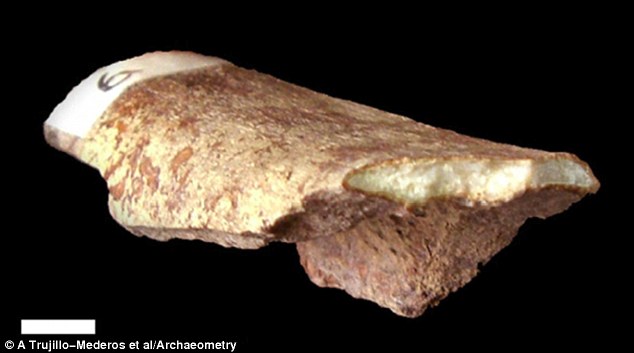
+7
Researchers have discovered that people living near what is now Mexico City, 2,000 years ago, grilled or boiled human flesh before seasoning it with chillies and saffron-like spices such as annatto. These spices, as well as the cooking techniques, dyed the bones yellow and red (an example of which is shown above)
The find is detailed in the study Savoury Recipes and the Colour of the Tlatelcomila Human Bones, published in the journal Archaeometry.
The team, from Ciudad University in Mexico and the Complutense University of Madrid, studied the remains of 18 people at Tlatelcomila, which is an archaeological site near Mexicos capital.
[h=3]ANCIENT CANNIBAL RECIPE[/h] Scientists identified the spices used to 'marinade' human flesh by ancient people living near Mexico City, based on the colour of bone fragments.
The colour must have been acquired before burial, either through thermal treatment, or through some organic dye, they write in the study.
They believe that cannibals grilled human flesh, as evidenced by red bones.
They also think they boiled it with spices including saffron-like annatto, pipián, which is still found in mole sauce and chilli peppers, shown by the discovery of yellow bones.
The bone fragments from skulls and long bones date to between 700 and 500 BC and have cut marks, facial mutilation and exposure to high temperatures, suggesting cannibalism.
But it is their red and yellow tinge that interested the experts and led them to uncover clues about how ancient cannibals prepared their food.
The colour must have been acquired before burial, either through thermal treatment, or through some organic dye, they wrote in the study.
Experts studied the microscopic structure, morphology and texture of the bones using techniques including X-ray diffraction and scanning electron microscopy to work out how the bones and flesh would have been cooked.
Distinguishing boiled bones from those that were grilled was a challenging task, but they found that microscopic changes in the bones textures revealed cooking techniques.
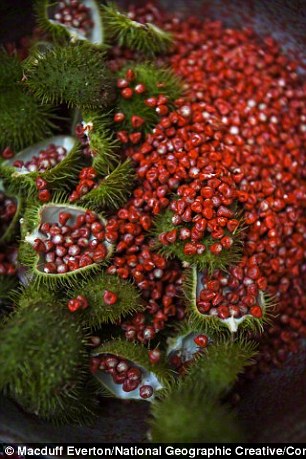
+7
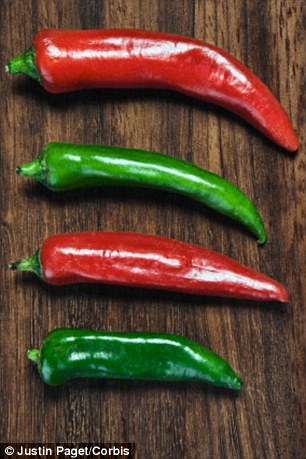
+7
Experts found the bones had been dyed yellow and red because flesh on the bone was 'marinated' in spices including saffron-like annatto (pictured left), pipián, still found in mole sauce, and chilli peppers (right)
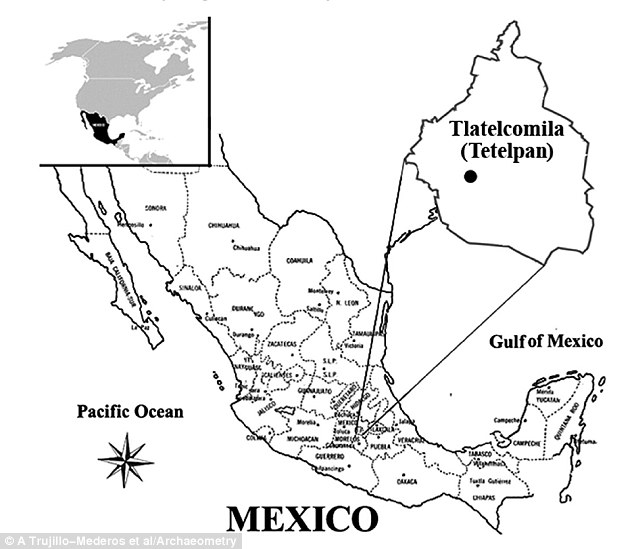
+7
Bone fragments suggesting cannibalism and dating to between 700 and 500 BC were discovered in Tlatelcomila (shown on the map) near what is now Mexico City
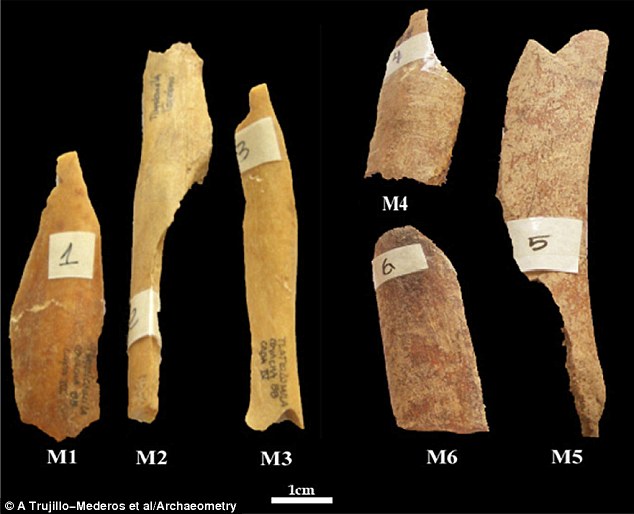
+7
The bone fragments from skulls and long bones (pictured) date to between 700 and 500 BC and have cut marks, facial mutilation and exposure to high temperatures, hinting at cannibalism
'In boiling, the bone salts tend to dissolve, promoting collagen surface migration, as shown by bones boiled in seawater, the study said.
[h=3]MEXICO'S CANNIBAL HISTORY [/h] The study does not specifically identify a group of people responsible for these cannibalistic acts, but it's not the first time evidence of cannibalism has been found in Mexico.
A group called Xiximes reportedly believed they could guarantee a good harvest if they consumed the souls of their enemies - often fellow tribesmen from neighbouring villages.
There had previously been no scientific evidence to back up those early accounts, often derided as hysterical exaggerations, but researchers in 2011 made a discovery of cooked and carved human bones from 1425.
The stained bones are much older than this, but it suggests a long history of the gruesome activity.
At the time of the 2011 discovery, José Luis Punzo, an archaeologist with the Mexican National Institute of Anthropology and History (INAH) said cannibalism 'was a crucial aspect of their world view, their identity.
'Through their rituals, cannibalism, and bone-hoarding, they marked a clear boundary between an "us" and "them".'
The rituals were tied to the agricultural cycle of planting and sowing corn.
After each harvest, Xiximes warriors were sent to hunt for flesh, preying often on lone men working in isolated conditions in the forest.
In boiled bones, the texture is homogenous and dark patches of inhomogeneous degradations are not observed.
This is the way, then, to distinguish boiling from grilling.
They believe the intensely red bones belong to humans whose flesh was grilled, because meat juices and blood diffused into the bones as the temperature increased.
The bones that are yellow were boiled with spices including saffron-like annatto, pipián, which is still found in mole sauce, and chilli peppers.
The spicy mixture dyed the bones the distinctive ochre colour.
These condiments contain high amounts of carotenoids, which are well known as dying agents, the study said.
To test the findings, the experts boiled a cow bone in an annatto solution - an ingredient still used in Mexican cooking.
'The resulting bone presented the same colour as the archaeological bones, showing that the bone surface colour can be attributed to the cooking of savoury dishes,' they wrote.
'The differences in colour [of the bone fragments] have to be attributed to the cooking recipes used in Mesoamerica.
The surface colour of the Tlatelcomila boiled bones may be explained by a combined effect of temperature, cooking time and the composition of the cooking liquid soup.
The study is important because it suggests cannibals in Mexico used similar recipes to prepare humans, as they did corn and other less gruesome ingredients than human flesh.
It does not specifically identify a group of people responsible for these cannibalistic acts, but it is not the first time evidence of cannibalism has been found in Mexico.
A group called the Xiximes reportedly believed they could guarantee a good harvest if they consumed the souls of their enemies - often fellow tribesmen from neighbouring villages - ate their bodies and hung their bones from trees as offerings to the spirits.
There had previously been no scientific evidence to back up those early accounts, often derided as hysterical exaggerations, but researchers in 2011 made a discovery of cooked and carved human bones dating back to 1425.
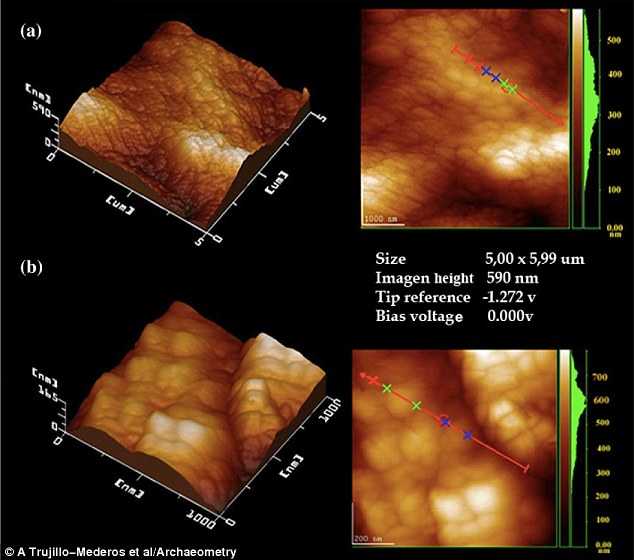
+7
Experts studied the microscopic structure, morphology and texture of the bones using techniques including X-ray diffraction and scanning electron microscopy to work out how the bones and flesh would have been cooked. This image shows 3D and 2D atomic force microscopy images of samples
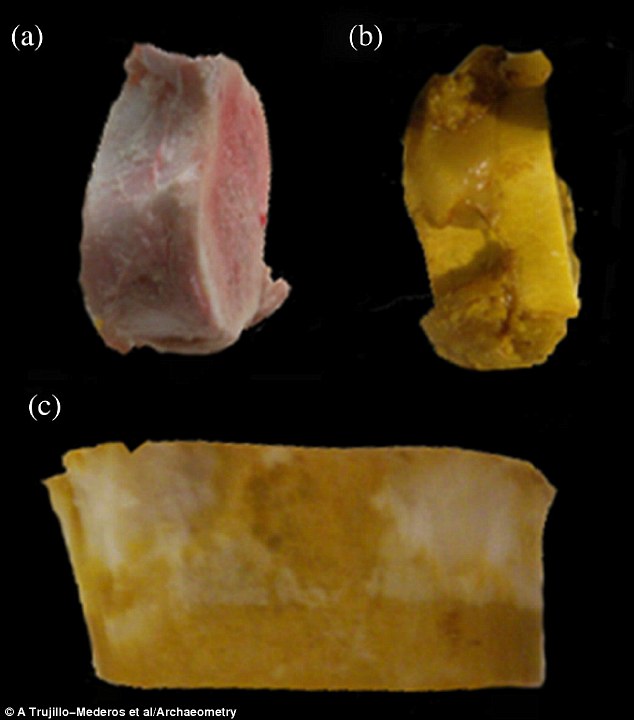
+7
To test the findings, the experts boiled a cow bone in an annatto solution - an ingredient still used in Mexican cooking. The fresh piece of bone is shown at (a), the bone cooked in the solution (b) and the bone cleaned and washed (c) showing the spice's ability to dye bone
The stained bones are much older than this, but it suggests a long history of the gruesome activity.
At the time of the 2011 discovery, José Luis Punzo, an archaeologist with the Mexican National Institute of Anthropology and History (INAH) said cannibalism 'was a crucial aspect of their world view, their identity.
'Through their rituals, cannibalism, and bone-hoarding, they marked a clear boundary between an "us" and "them".'
The rituals were tied to the agricultural cycle of planting and sowing corn, according to the research reported in National Geographic.
After each harvest, the warriors of the Xiximes were sent to hunt for flesh, preying often on lone men working in isolated conditions in the pine forest region, some 8,530ft above sea level.
[h=3]HUMAN SOUP WAS A ORE RECENT MEXICAN DELICACY[/h] A cache of cooked and carved human bones was discovered in 2011 at a site called Cueva del Maguey, dating back to 1425 and was home to the Xiximes tribe.
The bones were found in El Salto, Durango State in northern Mexico, in a cave hamlet built into a cliff.
The archaeological trove included more than three dozen human bones which showed evidence of having been defleshed, cooked and then ritualistically marked with stone blades.
Rumours of cannibalism among the 5,000-strong Xiximes have long existed due to the historical accounts of Jesuit missionaries, which labelled the tribe 'the wildest and most barbarian people of the New World' but until 2011, no evidence had been found.
The Xiximes apparently believed they could guarantee a good harvest if they consumed the souls of their enemies - often fellow tribesmen from neighbouring villages - ate their bodies and hung their bones from trees as offerings to the spirits.
Cannibalism 'was a crucial aspect of their world view, their identity,' said José Luis Punzo, an archaeologist with the Mexican National Institute of Anthropology and History (INAH).
The warriors brought their unwilling victims back to the village where they were ripped limb from limb.
The bones were cleaned and the flesh eaten in soup as part of an all-night celebration complete with tribal song and dance.
The bones were then stored in treasure houses until the start of the planting season when they would be hung from trees as an offering to the spirits the tribe believed would bless the crops.